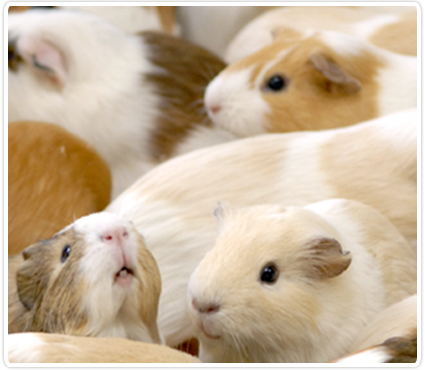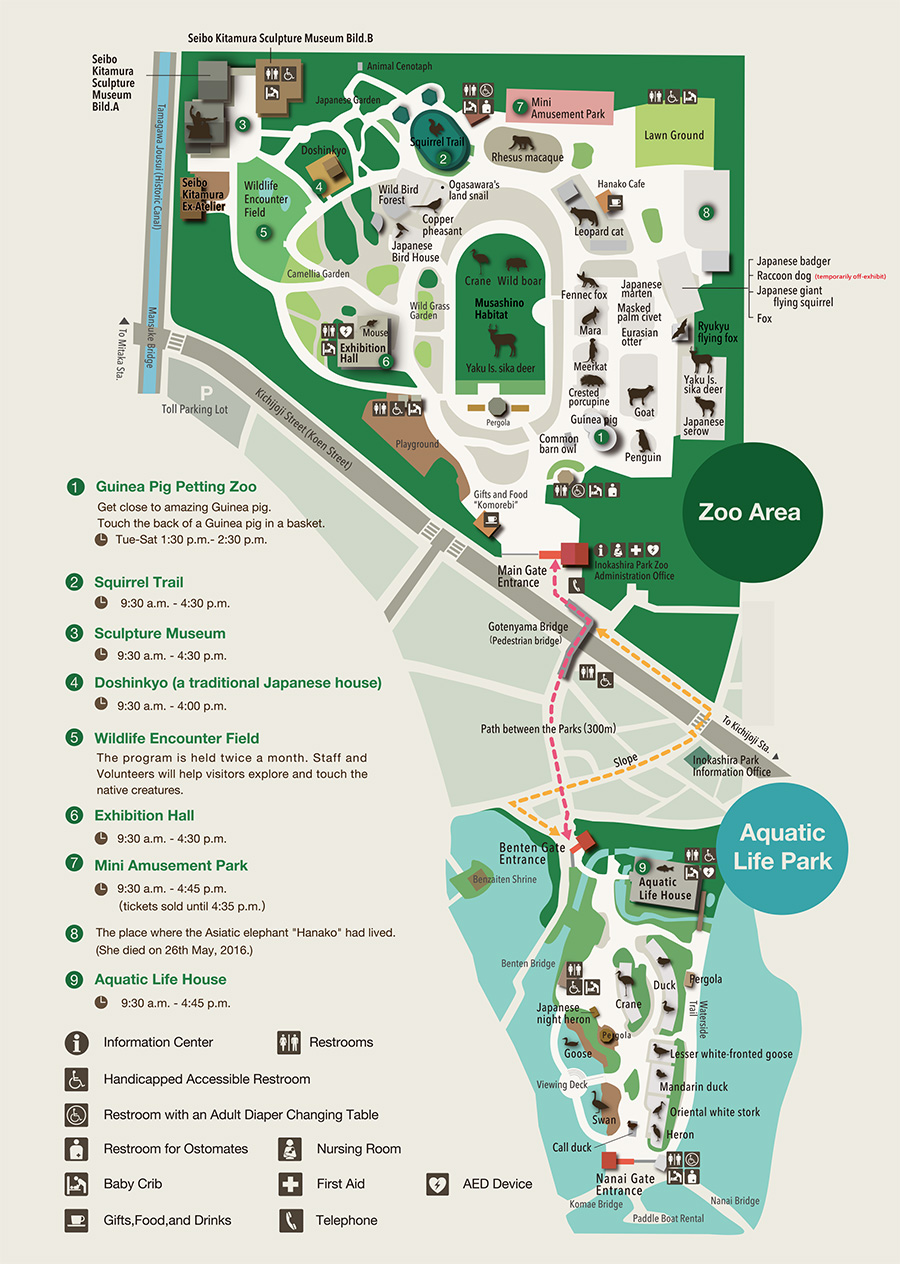


|
January 2026
 |
||||||
| Sun | Mon | Tue | Wed | Thu | Fri | Sat |
| 1 × |
2 | 3 | ||||
| 4 | 5 × |
6 | 7 | 8 | 9 | 10 |
| 11 | 12 | 13 × |
14 | 15 | 16 | 17 |
| 18 | 19 × |
20 | 21 | 22 | 23 | 24 |
| 25 | 26 × |
27 | 28 | 29 | 30 | 31 |
×=Closed |
||||||
| Hours:9:30-17:00 | ||||||
Entrance and ticket office close 1 hour prior to closing time.
Opens 9:30. to 17:00 (tickets sold until 16:00) and closes every Monday (closes Tuesday if Monday is a public holiday).
*The zoo closes from December 29 through January 1.
| General Admission | Annual Passport | |
| Adults (16-64) | 400 yen | 1600 yen |
| Seniors (65+) | 200 yen | 800 yen |
| Students (13-15) | 150 yen | ── |
| Children (0-12) | Free | ── |
*Free for junior high school students living in Tokyo or attending schools in Tokyo.
*Groups of 20 or more paying individuals are entitled to a 20% discount providing the group enters together through one entry at one time.
*Free admission for the disabled, and one assistant per disabled person.
*The admission is free on May 17 (Inokashira Park Zoo's Anniversary Day), May 4 (Greenery Day), and October 1 (Tokyo Citizens' Day).
We accept the following payment methods:
- Credit Cards (Visa, Mastercard, JCB, American Express, Diners Club, and Discover)
- e-money (Suica and all Suica-compatible IC transit cards)
- QR code payment (PayPay, Alipay, WeChatPay)
*Please note that we are unable to recharge IC transit cards.

Gift shops and snack bars.
No parking lots in the zoo. There's a toll one near the zoo, but it is advised that you take trains on holidays and weekends.
Inokashira Park Zoo is within 10 minutes' walk from Kichijoji Station of JR Line, Keio Inokashira Line, or Subway Tozai Line (Kichijoji is 15 minutes' train ride from JR Shinjuku station, or about 20 minutes' from Keio Inokashira Shibuya station).
From Kichijoji Station's Minami-Guchi (South Exit), go along the railroad to the right hand, then turn left at the first intersection, and walk about 5 minutes along the road.
*We have no parking lots, but there are toll ones in the vicinity.
Address: |
1-17-6, Gotenyama, Musashino-shi, |
Phone: |
0422-46-1100 |

Click here for a printable PDF map.
Some animals may not be exhibited depending on their physical conditions or weather conditions.
Inokashira Park Zoo is located in a suburb of Tokyo. It consists of “Zoo Area” and “Aquatic Life Park.” The former includes the animal zone and Sculpture Museum, and the latter includes the water bird exhibits and an aquarium located by Inokashira Pond.
The park, which still retains the remnants of the impressive old growth forest of Musashino, displays a total of more than 170 animal species with a focus of native Japanese species such as the Japanese squirrel and the Japanese serow as well as exotic species from around world such as the Fennec fox and the African crested porcupine. Their distinct characteristics may inspire children to have a lifelong interest in wildlife. In addition, various attractions such as Wild Grass Garden, Camellia Garden, Sculpture Museum and Japanese Garden are scattered around the park and show various seasonal expressions.
Contributing to the conservation of wildlife is one of the major roles of a zoo. At Inokashira Park Zoo, we are committed to the accumulation of breeding techniques for the ex-situ conservation of endangered native species such as the Tsushima leopard cat, Japanese fire belly newt, Black-faced spoonbill and Tokyo salamander.






※Some animals may not be exhibited depending on their physical conditions or weather conditions.
【Squirrel Trail】
The Japanese squirrel is an endemic species of Japan. They run freely in the tree-planted 650 m² cage. You can see the various seasonal lives of the squirrels, including their parenting in the spring and hoarding in the autumn.


【Japanese Bird House・Wild Bird Forest】
Beautiful little birds and pheasants living in hills and woods of Japan such as azure-winged magpies and copper pheasants, Japanese pheasants are displayed. You can also find raptors such as Japanese scops owls and Japanese sparrowhawks. The red-headed wood pigeon, an endemic bird of the Ogasawara Islands, is facing the risk of extinction, and the metropolitan zoos try to breed them in captivity.



【Guinea Pig Petting Zoo】
Get close to amazing guinea pigs. You can touch the back of a guinea pig in a basket (Tue-Sat 13:30-14:30).
Advance online ticket reservations are required.
>>Get your tickets and find out more, here.


【Tsushima leopard cat】
The Tsushima leopard cat is a wild cat and lives only in Tsushima Island, Nagasaki Prefecture. It is considered the most endangered mammalian species in Japan. We are working on the rearing and breeding of Tsushima leopard cats with methods such as the development of artificial insemination techniques using the Amur leopard cat which is a closely related species.


【Wildlife Encounter Field】
This field is created for the wild creatures living near the zoo by providing various habitat types, such as ponds and dense grasslands. Enjoy observing the native wildlife walking along the board walk.
>>Click here for details.



【Sculpture Museum】
 Nagasaki Peace Prayer Statue was created for the souls of the atomic bomb victims, and the atelier of Seibo Kitamura (1884-1987), where the statue was made, has been kept intact. The original model of the enormous Peace Prayer Statue which was divided into 104 pieces to transport to Nagasaki is impressive. A total of about 200 Seibo's sculptures are on display at Sculpture Museum Houses A, B and the outside.
Nagasaki Peace Prayer Statue was created for the souls of the atomic bomb victims, and the atelier of Seibo Kitamura (1884-1987), where the statue was made, has been kept intact. The original model of the enormous Peace Prayer Statue which was divided into 104 pieces to transport to Nagasaki is impressive. A total of about 200 Seibo's sculptures are on display at Sculpture Museum Houses A, B and the outside.
【Aquatic Life House】
At Aquatic Life House, we put emphasis on the display of creatures inhabiting the watersides of Japan, such as freshwater fish, amphibians, insects and plants.
You can also see rare species such as the Japanese killifish, Japanese giant salamander and Tokyo butterfly bitterling.



【Ducks, Geese, Herons and Cranes】
There is an extensive lineup of birds that live around the watersides in Asia, including endangered species such as the oriental white stork, Japanese night heron and black-faced spoonbill. You can see lively parenting from spring to summer as well as the courtship displays of birds such as beautiful breeding plumage of ducks from autumn to winter. From the viewing deck, you can enjoy observing various creatures such as wild birds visiting Inokashira Pond.


